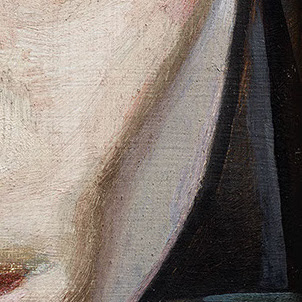Recently I've found myself bewitched by the early works of the British painter Lucian Freud.
Before he developed his mature style in the late 50s and early 60s — oils on canvas in wide, contour-ploughing brushstrokes — he was producing small, precise paintings on wood and copper, in a style no less unsettling than his later portraits but flatter, more lapidary and tempera-like.
Two paintings in particular stand out to me from this early period. The first, perhaps unusually for Freud, is not a portrait — at least not a human one — but his 1946 oil on panel The Birds of Olivier Larronde.
When I saw this picture I immediately thought: I get it. Why he painted this, why this arrangement appealed to his (almost morbidly recherche) taste. The red and white birdhouse echoes the same unreal note as those buildings in the backgrounds of early renaissance paintings by, say, Piero — the feeling of miniature, of proportional adolescence — the wistful mix of classical poise with toy-like artificiality.
And who resides in this dreamlike dwarf capriccio? An exotic race: the parakeet. Like the lemons and quinces in Freud's other paintings of this period, the tropical birds here punch through the gelid grays with their astringent El Greco citron.
White, black, crimson, blue-gray, yellow-green. The birdhouse's coated metal lends itself to young Freud's penchant for sharp, milky highlights and harsh gradations into desaturated shadows. And the rounder elements, the knobs — the feet on the bottom and the finial on top — let him reproduce that Phong shaded I've just discovered specular highlights! effect that's still so charming in Paolo Uccello.
Other delights:
The perfectly graphic black squares of perforation in the hipped roof's front polygon.
The slightly convex scalloped eaves.
The diagonal striping of the trellis — and above it, the balcony with fleur-de-lis railing.
All these delicately observed features are placed in a perspective that feels less certain, more wobbly and naïve if not libertine. For a picture so dominated by vertical lines, the whole thing feels a little off-kilter — the parallel edges of the birdhouse's underside, and the generous tilt which lends it so much area — these liberties seem to hover in that affinity between proto-Cubism and Byzantine icon painting.
The unifying theme of Freud's Birds — neoclassical heft rendered in a Flemish gothic both caustic and serene, with a touch of the African — is restated in his shockingly small oil on copper of 1950-51, Boy Smoking.
This is one of my favorite portraits. Such an amusing, confident, confrontational slab of anti-humanist humanity. Beautifully braids Picasso's 1907 primitivism with his Ingres-obsessed neoclassicism, then dips the double helix in an ice bath of Jan Van Eyck's spidery severity. So monumental, so sculptural, and yet so shallow and relief-like. How?
First, Freud crops — aggressively. Only the boy's nose and forehead are short. Everything else is enormous: the eyes, the lips, the cigarette. That cigarette! An almost perfect cylinder.
The eyes... Massive, steep, forbidding, like palisades glazed with ice — almost completely in shadow, save for a glint of wetness at the bottom of each, where they're aproned by the colossally deep shelf of the lower eyelid.
The top lip, a bat-like M with a wide, highlit arc for the philtrum. The lower lip, plump and cleft. Elvis in England, about five years early.
So many lessons on temperature in this one: warm, ruddy shadows in the corners of the eyelids and the meeting of the lips. Cool, moldy gray in the right temple, the crease under the left eyelid, the bulge of the mouth beyond the lips. Hot pink fringing on the shadows under the nose and mouth. The whole left jaw under the brown contour of the cheek: a pale, peach fuzz-diffused taupe.
Though his later portraits wouldn't be so linear, Boy Smoking does establish Freud's caricature-exaggerated-but-frighteningly-volumetric aesthetic for portraiture as well as his typical palette: ochre, rose and slate.
There are certainly other treasures in Freud's 1940s and 50s — his zebras, his (dead) monkeys, his potted plants, his overcast trip to Jamaica and especially his profoundly prehensile drawings of his second wife, the writer Caroline Blackwood — but these two, Boy Smoking and The Birds of Olivier Larronde, really stand out to me as quintessential examples of the technique and sensibility of the young Lucian Freud: private, precise, tiny yet colossal, muted and austere yet acidic and almost perverse — pockets of exotic pleasure surrounded by cozy drabness, like a child's favorite corner.









